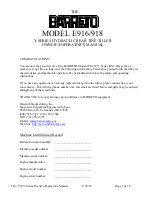
10
IM620-1
Expansion Bus Connection
The Expansion Bus connector sends output signals to the Analog Output Expansion Module (see the
“Accessories” section) via a ribbon cable. The output signals are used by the Analog Output
Expansion Module to drive various control devices.
Communication Ports
The MCB has two communication ports: port A and port B. Each port has six terminals and is set up
for both the RS-232C and RS-485 data transmission interface standards. The male and female
connectors for these ports are manufactured by AMP. Therefore, they are referred to as “AMP plugs”
or “AMP connectors” throughout this manual. Socketed fuses located next to the ports protect the
communications drivers from voltage in excess of ±12 V. Following are brief descriptions of each
port’s function.
Port A:
Port A is for communications with an absorption chiller unit controller, another
manufacturer’s BAS interface device, or an IBM compatible PC using the RS-232C
interface standard. When port A is used for communications with the absorption chiller
unit controller, the communications rate is 4800 bps with an interface standard of RS-485.
When port A connects to the BAS interface device or a PC, the communications rate is
9600 bps. The PC can be directly connected, over a limited distance, with a twisted,
shielded pair cable. For more information, see “PC Connection” in the “Field Wiring”
section of this manual.
Port B:
Port B is for network communications between the MAG and the absorption chiller, or the
MAG and the level-1 MicroTech controller using the RS-485 interface standard. A twisted,
shielded pair cable should be connected to port B via terminals B+, B–, and GND on
terminal block T11. The communications rate is 9600 bps. For more information, see
“Network Communications” in the “Field Wiring” section of this manual.
Output Board
The Output Board (OB) accepts up to 24 digital outputs from the MCB. Each output has fused
sockets and can be used to drive an AC or DC load by selecting a particular relay output module.
Screw terminals allow for field wiring connections to the output device. Each output has an onboard
LED that illuminates when an output socket that contains a relay is activated by the MCB. Following
are the Output Board’s power ratings.
•
120V ~ 50/60 Hz
•
250V ~ 50/60 Hz
Input Conditioning Module Terminal Board
The Input Conditioning Module (ICM) Terminal is provided for possible future applications. The ICM
Terminal Board has three edge card connectors, field wiring terminals for analog and digital inputs,
field wiring terminals for 5 Vdc and 24 Vac, field wiring terminals for communication ports, and ribbon
cable connections to the MCB.
Power
Above each edge card connector are field wiring terminals for 5 Vdc (regulated) and 24 Vac (ground
referenced). These terminals can be used to power peripheral devices. It is also used to power the
LEDs in the Output Board.
Communications
Also located on the ICM Terminal Board are communications field wiring terminals. Terminals B+, B–,
and GND connect to either a level–1 controller’s communications field wiring terminals or to the
absorption chiller. Terminals A+, A–, and GND connect to the BAS integrator, the absorption chiller,
or a PC. Both sets of terminals have an AMP connector that attach to the MCB port A and port B.











































